
October 19, 2023
1020x2020mm Rooflight with Integral Blind Skylight Roof Window
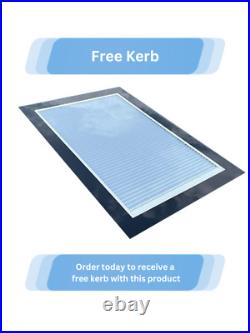
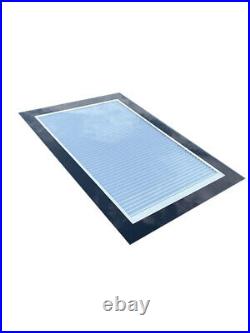
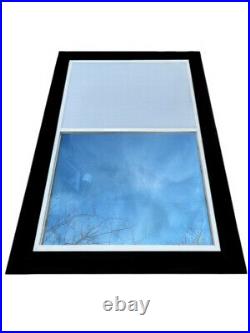

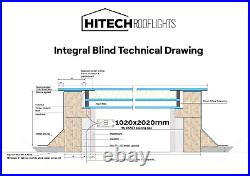
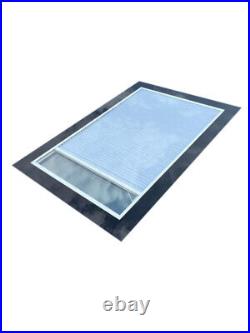
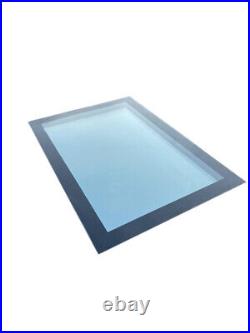

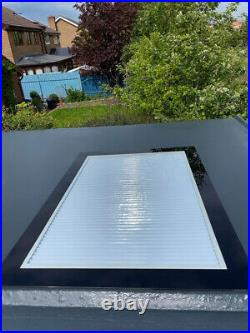
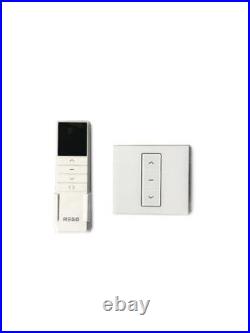

Extended 20-year unit guarantee. Collect in as little as one hour. Triple Glazed 64mm thick units (6mm clear toughened – 30mm spacer – 6mm low-e toughened – 16mm spacer – 6mm low-e toughened). Amazing U Value: 0.81W/m³. EnduroShield easy-clean surface coating technology. Outstanding durability and reliability. Designed to reflect the heat. Light and shade control. Sealed within the glass unit. No dust, dirt or damage. Remote controlled integrated electric blind. The HITECH ROOFLIGHTS range of products has been specifically designed and precisely manufactured to provide high-performance units combined with the highest levels of energy efficiency and excellent through-life operation. Our integrated rooflights are manufactured with industrial-grade components including toughened glass to all panes, an external ceramic border and a warm-edge spacer bar ensuring premium quality. The HITECH ROOFLIGHTS also feature EnduroShield’s easy-clean surface coating technology as standard. When it comes to choosing your rooflight, it is important to consider 3 things. Size – what size will best suit your space and needs? Heat – do you need shade control to manage the temperature of your room? Light – do you need to control the light coming in to your space? With these 3 questions in mind we have created a range of roof lights in various sizes that should met your needs. Whilst it is important to have natural light flooding into your space it is equally important that you can control this light. Until now the only way you could do this would have been to retro fit a blind that sits on the inside walls of your plastered roof light. Whilst these work well they do come with potential issues. Cleaning- Dust, bugs, flies and spiders love to hide in these sorts of spaces, flies especially fly up and tend to die and fall on-top the blind or the track and frame. The blind will need regular hovering cleaning in order to keep it in tip top condition. Damage- as the blind is exposed it will be subject to potential damage whether from moisture, sunlight and accidental damage. Unsightly- as they are fitted after the rooflight the track and guide rails will be on show meaning the visible glass area will be reduced and the rails will be seen. Now with the Hightec Electric Blind rooflights all these issues are gone. Cleaning- The blind is sealed within the glass unit, which protects them from Dust, Bugs, Flies or spiders and damage. The integral blind provides a sleek and modern appearance as they are integrated seamlessly into the roof light. They offer a clean and uncluttered look to the interior and exterior of your space. Why choose an integral blind over a traditional rooflight blind? Integral Rooflight Blind Inside Glass. Traditional Rooflight Blind Outside Window. Installed between glass panes during manufacturing process. Installed externally underneath the rooflight frame or structure. Provides a sleek, minimalist look with no visible cords or mechanisms. May have visible cords or mechanisms on the exterior. No dust or dirt. Blinds may discolour due to UV exposure. Provides an additional layer of insulation due to being enclosed within the glass unit. May provide some insulation, but not as effective as an integral blind. Offers precise light control and shading, with various opacity levels available. Offers adjustable light control, but may have some gaps that allow light to seep through. Protected from wear and tear, as it’s shielded within the glass unit. Dependant on material used. Does not take up additional space within the room as it’s within the glass. Takes up some space on the external frame or structure. HITECH Rooflights offer a bespoke service and can make almost any size or shape. Offers a wider range of blind types, colors, and patterns. Provides UV protection when closed, preserving furniture and interiors. Offers UV protection when closed, but some UV might penetrate through gaps. Can provide some level of sound insulation due to the double glazing. May provide limited sound insulation depending on the design. The rooflight will to delivered fully complete and ready to install. Requires professional installation after the rooflight is in place. Slide the arrows to see the impact of Hitech rooflights Integrated Rooflight Blinds. Download our installation guide here to get all the information you need to install our rooflights. Why should you choose rooflights for your home? What are the benefits of an integral blind in a rooflight? Integral blinds in rooflights offer a range of benefits, including. Aesthetics: Integral blinds are seamlessly integrated within the rooflight structure, providing a sleek and unobtrusive appearance that enhances the overall aesthetic appeal of the space. Sunlight Control: Users can easily adjust the blinds to regulate the amount of sunlight entering the room, preventing glare and excessive heat buildup while maintaining a comfortable indoor environment. Privacy: Integral blinds offer on-demand privacy, allowing occupants to control visibility from both inside and outside the room without the need for additional window coverings. Protection from UV Rays: Integral blinds can help block harmful ultraviolet (UV) rays, protecting furniture, flooring, and other interior elements from fading and deterioration. Energy Efficiency: By adjusting the blinds to manage sunlight and heat, integral blinds contribute to better energy efficiency, reducing the need for artificial lighting and cooling systems. Easy Maintenance: Because integral blinds are protected within the glazing unit, they are less exposed to dust and dirt, resulting in reduced maintenance requirements compared to traditional window coverings. Noise Insulation: Integral blinds can provide an additional layer of sound insulation, helping to reduce external noise and create a quieter indoor environment. Child and Pet Safety: Unlike external blinds or curtains, integral blinds have no dangling cords or strings, making them a safer option for households with children and pets. Longevity: Protected from external elements, integral blinds tend to have a longer lifespan compared to traditional blinds that are exposed to weather conditions. Uninterrupted Views: When raised, integral blinds are completely hidden within the glazing unit, ensuring uninterrupted views to the outside and maximizing the enjoyment of scenic surroundings. Hygiene and Allergen Control: Integral blinds are less likely to collect dust and allergens, contributing to better indoor air quality and reducing potential allergen exposure. Customization: Integral blinds come in a variety of colors and designs, allowing users to tailor the appearance to match their interior décor and personal preferences. Overall, integral blinds in rooflights provide a sophisticated and practical solution that enhances the comfort, functionality, and visual appeal of living or working spaces. What does U Value: 0.81W/m³ mean? The term “U-value” is a measure of thermal transmittance, indicating how effective a building material such as windows, walls, roofs, etc. Is at preventing heat from escaping or entering a building. It is a measure of heat transfer through a given area of a material or assembly (such as a window) per unit temperature difference between the inside and outside. In the context of the value “U-value: 0.81 W/m²K”. U-Value: The U-value itself is expressed in units of watts per square meter per Kelvin (W/m²K). It represents the amount of heat energy that passes through one square meter of a material or structure when there is a temperature difference of 1 Kelvin (equivalent to 1 degree Celsius) between the indoor and outdoor environments. 0.81 W/m²K: This specific U-value value of 0.81 W/m²K means that for every 1 Kelvin (or 1 degree Celsius) of temperature difference between the indoor and outdoor environments, heat energy will flow at a rate of 0.81 watts per square meter through the material or structure. In practical terms, a lower U-value indicates better thermal insulation. A U-value of 0.81 W/m²K suggests that the material or assembly has relatively good insulation properties, meaning it can help to minimize heat loss or gain through that particular area. This is particularly important for building components like windows, doors, and walls, where maintaining a comfortable indoor temperature and energy efficiency are key considerations. Keep in mind that U-values are just one part of assessing the overall energy performance of a building. Other factors such as solar gain, air leakage, and the overall thermal properties of the building envelope should also be considered for a comprehensive evaluation of energy efficiency. What is an integral blind? An integral blind, also known as an integrated blind or built-in blind, is a type of window covering system that is incorporated within the glazing unit of a window or door. It consists of blinds that are sealed between two layers of glass, creating a single integrated unit. This design allows the blinds to be operated and adjusted without any external cords, strings, or mechanisms. Instead, integral blinds typically have a control mechanism built into the window frame that enables users to raise, lower, and tilt the blinds to control light, privacy, and heat entering the room. Integral blinds offer several advantages over traditional window coverings. Aesthetic Appeal: Since integral blinds are enclosed within the glass, they provide a clean and modern appearance that doesn’t disrupt the window’s design. Hygiene and Maintenance: Being sealed within the glazing unit protects integral blinds from dust, dirt, and moisture, reducing maintenance needs and improving hygiene. Child and Pet Safety: Integral blinds eliminate the risk of dangling cords, making them a safer option for households with young children and pets. Energy Efficiency: Integral blinds can contribute to better energy efficiency by helping to control heat gain and loss, which in turn reduces the reliance on heating and cooling systems. Privacy and Light Control: Users can easily adjust the blinds to manage sunlight and privacy levels within the room. Longevity: Integral blinds are well-protected from external elements, which can extend their lifespan compared to traditional blinds. Integral blinds are commonly used in various settings, including residential homes, commercial buildings, offices, healthcare facilities, and educational institutions. They come in various materials, colors, and control mechanisms to suit different design preferences and functional requirements. What is Easy Clean Glass? Easy-clean glass, also known as self-cleaning glass, is a specialized type of glass that has been treated with a coating to make it easier to clean and maintain. This coating typically consists of a thin layer of titanium dioxide and other materials that create a hydrophilic surface. Here’s how it works. Hydrophilic Properties: The coating on easy-clean glass makes the glass surface hydrophilic, which means it has an affinity for water. When water comes into contact with the glass, it forms a thin, even sheet instead of forming droplets. This helps to spread out dirt, dust, and contaminants across the surface. Photocatalytic Action: The titanium dioxide in the coating also has photocatalytic properties. When exposed to sunlight or UV radiation, it triggers a chemical reaction that breaks down organic materials (such as dirt, organic pollutants, and even some types of bacteria) on the glass surface. Lotus Effect: The combination of hydrophilic properties and photocatalytic action mimics the “lotus effect, ” where water droplets easily roll off lotus leaves, carrying away dirt particles. Similarly, on easy-clean glass, water helps to flush away dirt and contaminants, leaving the glass cleaner. The benefits of easy-clean glass include. Less Maintenance: Since dirt and contaminants are more easily removed by rain or water, easy-clean glass requires less frequent cleaning and maintenance. Improved Aesthetics: Windows, glass doors, and other surfaces made with easy-clean glass tend to maintain a cleaner and clearer appearance over time. Time and Effort Savings: Cleaning easy-clean glass surfaces becomes easier and requires less effort compared to regular glass. Environmental Impact: Reduced cleaning frequency means fewer cleaning products are required, which can lead to less environmental impact due to the use of cleaning chemicals. Easy-clean glass is commonly used in residential and commercial applications, such as windows, skylights, glass facades, conservatories, and other areas where glass surfaces are exposed to the elements. It is important to note that while easy-clean glass can reduce the need for frequent cleaning, it does not eliminate the need for occasional maintenance and cleaning to keep the glass looking its best. Leak-Proof Design – What does this mean for my Rooflight? A “leak-proof design” for a rooflight refers to a design approach and construction that minimizes the risk of water infiltration or leakage through the rooflight structure. Rooflights are essentially windows or skylights installed in the roof of a building to allow natural light to enter interior spaces. Ensuring that a rooflight has a leak-proof design is crucial to preventing water damage, maintaining indoor comfort, and protecting the structural integrity of the building. Here’s what it means for your rooflight. Water Resistance: A leak-proof design involves using materials, seals, and construction techniques that prevent water from infiltrating through the rooflight into the building. This includes watertight seals, gaskets, flashing, and other components that are designed to create a barrier against rain, snow, and other moisture. Quality Seals and Gaskets: The joints and connections of a rooflight are vulnerable points where water can seep through. A leak-proof design will utilize high-quality seals, gaskets, and weatherstripping materials to ensure that these areas are effectively sealed against water intrusion. Proper Installation: Even the best-designed rooflight can leak if it’s not installed correctly. A leak-proof design takes into account proper installation procedures to ensure that the rooflight is securely and tightly fitted into the roof structure. This includes proper flashing installation and effective integration with the roofing material. Testing and Certification: Reputable rooflight manufacturers often subject their products to rigorous testing to verify their leak resistance under various weather conditions. Look for rooflights that have been certified or tested for water tightness by relevant industry standards. Durability and Longevity: A leak-proof design also considers the long-term durability of the rooflight materials and components. Over time, exposure to weather and temperature changes can affect the performance of seals and other elements. A well-designed rooflight should be able to maintain its leak-resistant properties for many years. Maintenance: While a leak-proof design significantly reduces the risk of leaks, regular maintenance is still important. Keeping the rooflight clean, inspecting seals and flashing, and addressing any potential issues promptly can help prolong its leak-resistant properties. Overall, having a leak-proof design for your rooflight means you can trust that the installation will effectively keep water out of your building, preventing water damage, mold growth, and other related issues. When glass is impact resistant what does this mean? When glass is described as “impact resistant, ” it means that the glass has been designed and manufactured to withstand impacts, shocks, or forces without shattering or breaking into sharp, dangerous shards. Impact-resistant glass is engineered to enhance safety and security in various applications, particularly in situations where there’s a higher risk of breakage due to accidents, weather events, or intentional actions. There are several types of impact-resistant glass, each with its own properties and applications. Tempered Glass: Tempered glass is heated and then rapidly cooled during the manufacturing process, which creates internal stresses and makes the glass much stronger than regular annealed glass. When tempered glass is broken, it shatters into small, relatively harmless pieces instead of large, sharp shards. Laminated Glass: Laminated glass consists of multiple layers of glass with a layer of polymer, usually PVB (polyvinyl butyral), sandwiched in between. This polymer layer holds the glass together when shattered, preventing it from breaking apart completely. Laminated glass is commonly used in car windshields and buildings where safety is a priority. Polycarbonate Glazing: While not traditional glass, polycarbonate is a strong and impact-resistant material that can be used as a substitute for glass in certain applications. It’s commonly used in areas where breakage is a concern, such as skylights, greenhouses, and sports facilities. Security Glass: This type of glass is designed to resist not only impacts but also attempts to break through the glass, such as during forced entry or vandalism. Security glass often combines features of tempered and laminated glass to provide both strength and resistance to penetration. Impact-resistant glass is used in a range of applications, including. Automotive Windows: Windshields and side windows in vehicles are often made with laminated glass to protect occupants from shattered glass during accidents. Hurricane Protection: Impact-resistant glass is crucial in areas prone to hurricanes or severe weather. It can withstand flying debris and high winds, reducing the risk of breakage and protecting occupants. Architectural Applications: Impact-resistant glass is used in windows, doors, and facades of buildings, especially in locations susceptible to extreme weather or security concerns. Sports Facilities: Impact-resistant glazing is used in sports facilities to prevent injuries from high-speed balls or other objects hitting the glass. Industrial Settings: In industrial environments, impact-resistant glass is used to protect workers and equipment from potential hazards. In summary, “impact resistant” glass is designed to minimize the risk of shattering upon impact, enhancing safety and security in a variety of settings. The specific type of impact-resistant glass used depends on the intended application and the level of protection required. What does Argon gas insulated mean? “Argon gas insulated” refers to a type of insulation commonly used in windows or glass units. It involves filling the space between glass panes with argon gas, creating a more energy-efficient and thermally insulating window. Here’s how argon gas insulation works. Double or Triple Glazing: Windows can be single glazed (one glass pane) or double glazed (two glass panes with a gap in between) or even triple glazed (three glass panes with gaps in between). The space between these glass panes can be filled with air or a specialized insulating gas like argon. Argon Gas: Argon is a colorless, odorless, and non-reactive noble gas that is denser than air. Because of its higher density, it is used between glass panes to create a barrier that reduces heat transfer. When used as insulation, argon gas slows down the transfer of heat through conduction and convection. This means that during hot weather, less heat from outside enters the building, and during cold weather, less indoor heat escapes to the outside. Thermal Insulation: Argon gas insulation enhances the overall thermal performance of the window by reducing heat loss or gain through the glass. This can lead to improved energy efficiency, lower heating and cooling costs, and increased comfort within the building. Sound Insulation: In addition to thermal insulation, argon gas-filled windows can also provide improved sound insulation. The denser gas helps reduce sound transmission through the window, creating a quieter indoor environment. Manufacturing Process: The process of incorporating argon gas into windows involves sealing the edges of the glass panes to create an airtight space. This prevents the gas from escaping and outside air from entering. The sealed unit is designed to be maintenance-free and to retain the insulating properties of the gas over time. Overall, windows that are “argon gas insulated” are designed to provide better insulation compared to traditional air-filled windows, contributing to energy savings, improved comfort, and potential noise reduction within buildings. What does Triple Glazed 64mm thick units mean? “Triple glazed 64mm thick units” refers to a type of window or glass unit commonly used in construction and architecture. Let’s break down the meaning of each part. Triple Glazed: This indicates that the window or glass unit is composed of three layers of glass, as opposed to the more common double-glazed units that have two layers of glass. Triple glazing provides better insulation, soundproofing, and energy efficiency compared to single or double glazing. The multiple layers of glass create additional barriers to heat transfer and noise transmission. 64mm Thick: This refers to the overall thickness of the entire window or glass unit. In this case, the unit is 64mm (millimeters) thick. The thickness includes not only the layers of glass but also the space between the glass panes, any insulating gas (such as argon or krypton) that might be sealed between the panes, and the framing material. In summary, “triple glazed 64mm thick units” describes windows or glass panels that have three layers of glass and a total thickness of 64mm. This type of unit is known for its enhanced insulation and soundproofing properties, making it a popular choice for energy-efficient and noise-reducing building designs. What additional features do HITECH integrated blinds have? Black Ceramic Painted Boarder. White Blind Inside and Out. Blind Opens on the Longest Edge. 20 s/m Running Speed. Tested to 50,000 Repetitions. 24v Transformer wall switch. We know that discount matters when maximising your profits margins on commercial projects. For that reason we have created a simple easy TRADE account. TRADE accounts are only available to operating commercial businesses. Register for trade account.
